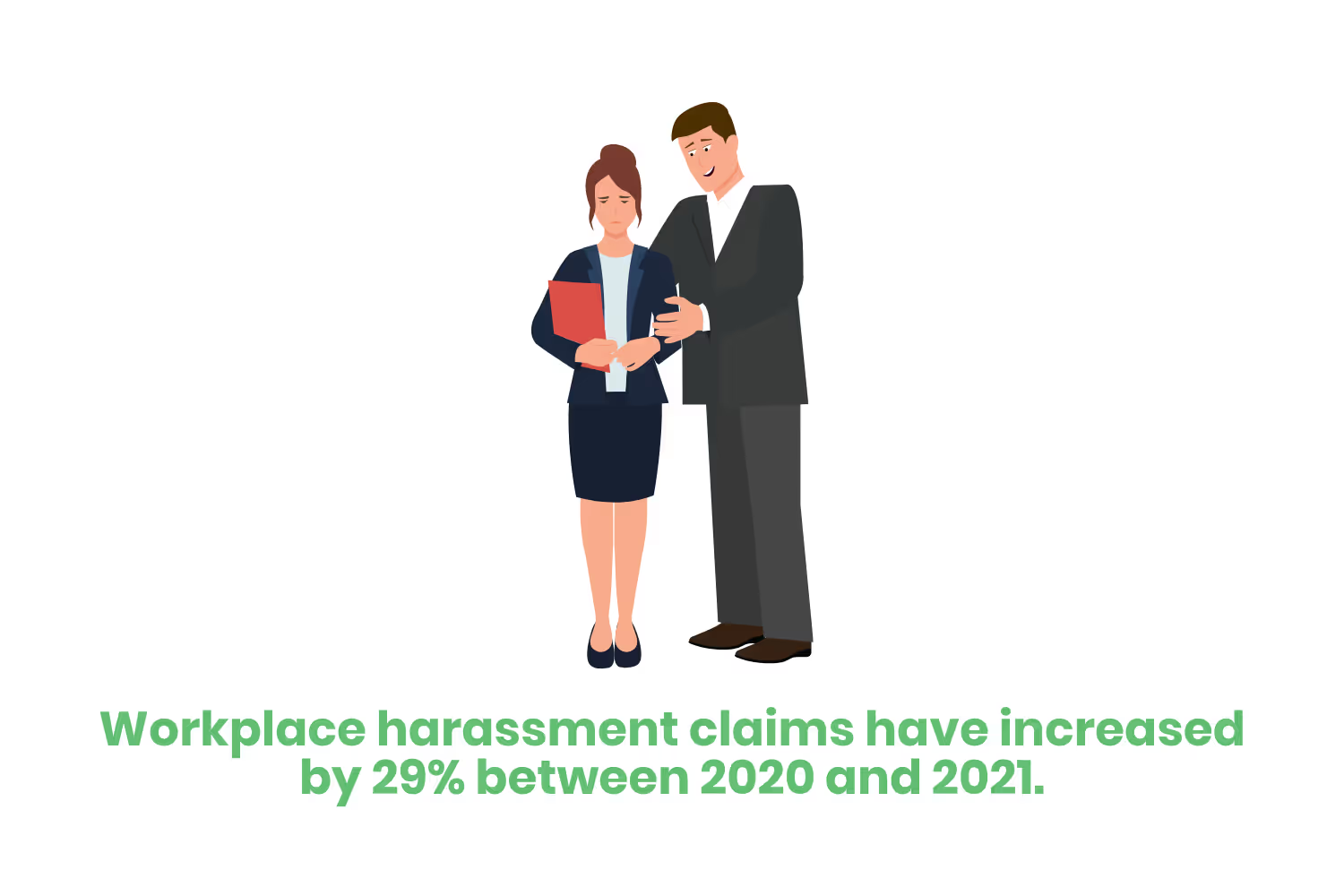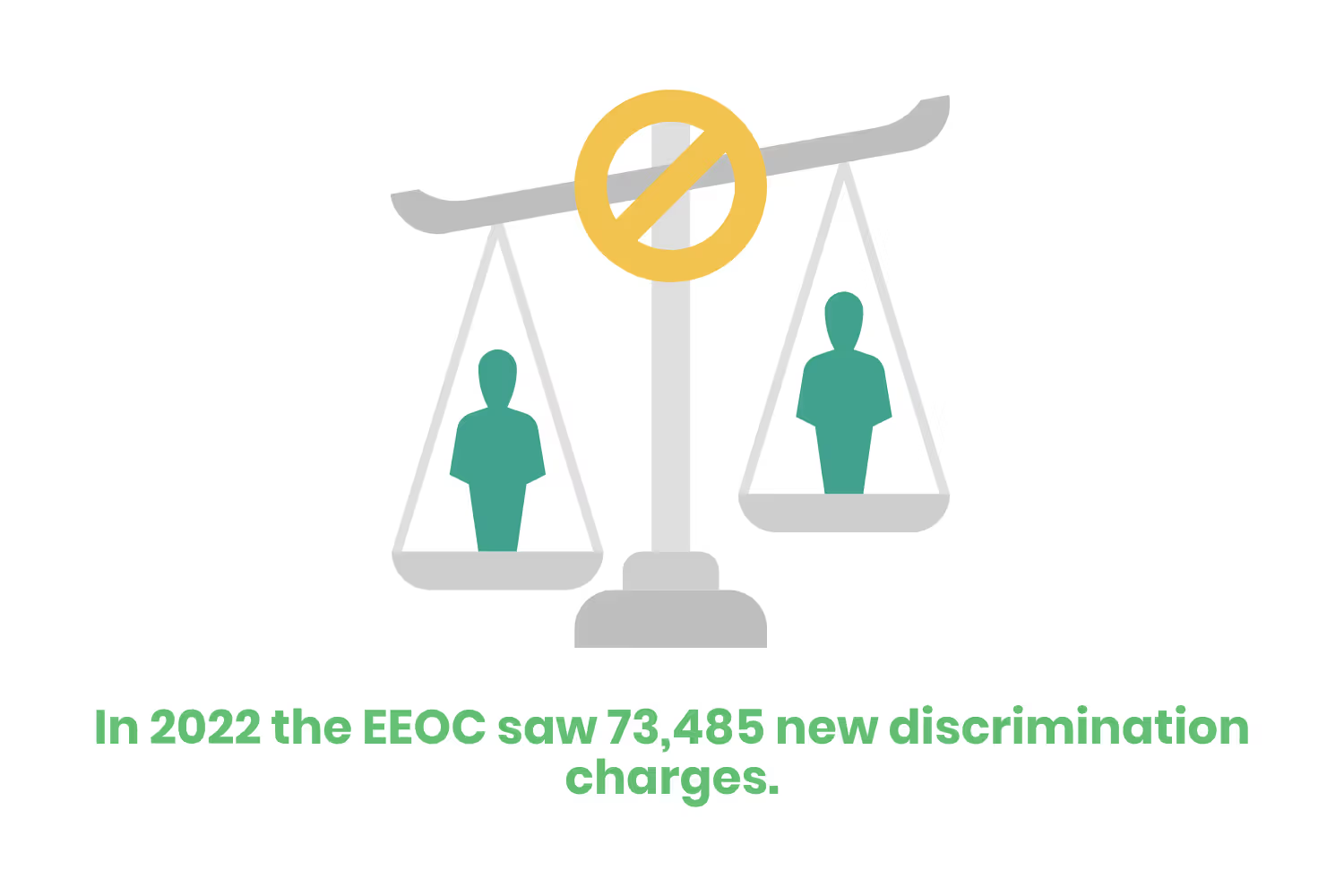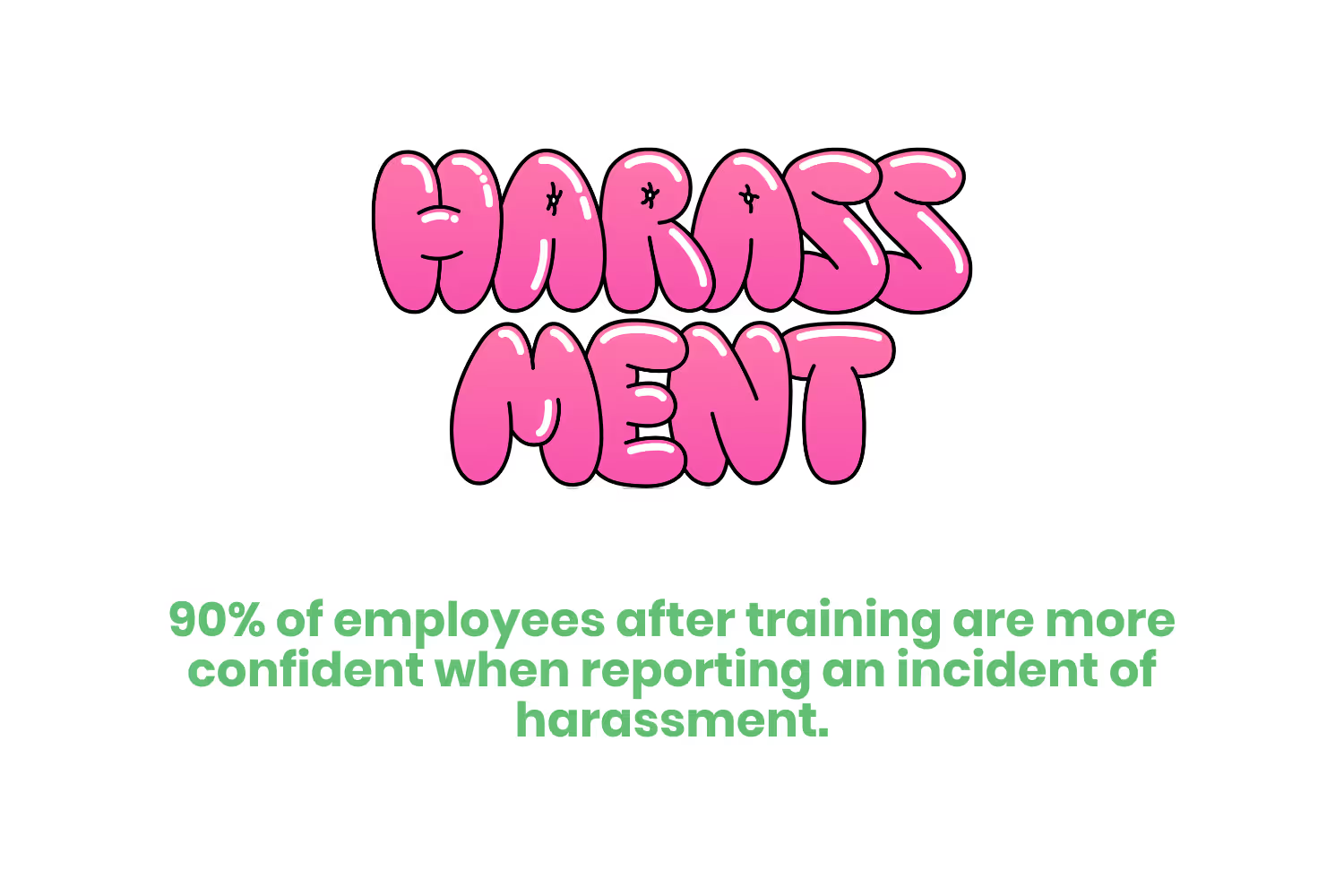[ANSWERED] Whose Responsibility is it to Prevent Workplace Harassment?
Harassment in the workplace is evolving and shows no signs of slowing down. While It takes teamwork and cooperation from everyone to create and enforce an effective anti-harassment program in any organization. Whose ultimately responsible for preventing it from happening?

According to research from Embroker, workplace harassment claims increased by 29% between 2020 and 2021. What does this mean? Harassment in the workplace is evolving and shows no signs of slowing down.
Unfortunately, harassment doesn’t seem to be slowing down with the increased trend in remote work either. Nearly 40% of workplace harassment victims report experiencing remote harassment. At the same time, it’s now becoming easier to collect data and evidence in workplace harassment cases.

This is where the Equal Employment Opportunity Commission (EEOC) comes into play. The EEOC is responsible for educating workers and employers about workplace harassment and the best ways to prevent it. Not only prevention training, but also what to do if you face workplace harassment or witness someone else experiencing it.
The EEOC investigates, mediates, litigates and adjudicates thousands of harassment claims a year. In fact, for the 2022 fiscal year the EEOC saw 73,485 new discrimination charges.
But promoting best practices to stop this conduct before it becomes a legal issue is not just the government’s responsibility.
It takes teamwork and cooperation from everyone to create and enforce an effective anti-harassment program in any organization. When applied and upheld by all parties involved, the system encourages people to come forward and hold leadership and supervisors accountable.
Defining Harassment
So let’s take a look at what workplace harassment is. We will break it down to defining the term “harassment”, first. Harassment is verbal or physical conduct that demonstrates hostility or aggression toward an individual due to:
- Race
- Skin Color
- Religion
- Sex (Sexual Orientation, Gender Identity, Pregnancy Status)
- National Origin
- Age
- Disability
Disparaging comments and remarks on any of these topics constitute harassment when the perpetrator has the intent to create an intimidating, offensive, or hostile work environment for the victim. It’s harassment when this behavior interferes with the victim’s work performance or otherwise adversely affects their employment opportunities.

Harassing conduct can include but is not limited to:
- Slurs
- Verbal or written threats
- Hostile jokes or pranks/Hostile acts in general
- Graphic material that displays aversion toward an employee
- Negative stereotyping
- Epithets
If you’re unsure whether something constitutes harassment, refer to the “reasonable person” standard. If you or someone you know is in a situation that might constitute harassment, think about whether a reasonable person in the same situation might consider it inappropriate. If you think a reasonable person might think the conduct is intimidating, hostile, or abusive… it most likely is.
This standard must assume the “reasonable person” in this situation is of the same race, color, sex, religion, national origin, age, or disability as the victim. So if a female employee is making a complaint, to apply the “reasonable person” standard, she must take the perspective of another woman. If another woman might consider the behavior harassment, it likely is.
When handling a claim of harassment in regard to sex, the legality of handling this complaint stays relatively similar but falls under a specific category. Let’s talk about sexual harassment.
Sexual Harassment
It is important to know the subtle distinctions that constitute this type of harassment. So what exactly constitutes sexual harassment?
Well, there are many different types. But, it can look like unwelcome sexual advances, verbal or physical sexual conduct, or requests for sexual favors.
This is sexual harassment when one or more of the following apply:
- Someone feels that they must submit to the conduct in order to keep their job.
- A person feels that any employment decisions depend on if they allow this inappropriate behavior. This includes raises, promotions, and demotions.
- The conduct affects the victim’s professional performance.
The conduct creates an intimidating, offensive, or hostile work environment.
There are two common types of sexual harassment that I will briefly go over with you: Quid pro quo and hostile work environment.

Quid pro quo means "this for that". A person of power or authority uses this tactic in the workplace in hopes of gaining control of another employee. This involves demands for sexual favors in exchange for some benefit. In contrast, demands for sexual favors can also be in exchange for avoiding punishment.
Hostile work environment harassment perpetrators can be anyone in the organization. This includes peers, supervisors, subordinates, customers, etc.
Examples of conduct that might create a hostile work environment include:
- Unwanted sexual innuendo
- Propositions
- Sexual attention
- Suggestive comments.
- Jokes
- Insults
- Derogatory language about sexuality, gender, gender identity, or sexual orientation
- Unwelcome physical contact or suggestive body language
- Unwanted sexually explicit photos, emails, or text messages
Anti-Harassment Training and Policy
Offering training and having policies and procedures in place to deal with harassment claims lets your employees know that this issue is a priority in your organization. With the correct training, you can not only avoid a lawsuit but your employees will feel more connected to their upper management team as well as their coworkers.
For instance, an increased feeling of safety at work can contribute to better employee confidence, healthy relationships, and better productivity. A report from The Purple Campaign reveals that 90% of employees after training are more aware of how to report an incident of harassment.

When It comes to dealing with workplace harassment, being proactive rather than reactive is the key. Start by fostering a workplace environment that actively prevents harassment. You can do this by developing an anti-harassment policy.
Make sure this policy and company expectations are available to all employees.
When it comes to a written policy you should include the following:
- A definition of harassment
- Harassment prohibition statement
- Description of the complaint procedure
- Description of disciplinary steps
- Statement of protection in regard to retaliation
Who is Responsible
The responsibility of fighting against workplace harassment falls on the shoulders of everyone that works at your organization (including you). As for who can be a perpetrator, it’s not just coworkers or supervisors. Vendors and third parties can commit acts of harassment, as well as customers.
Your Employer
The majority of harassment training and prevention falls on your workplace. There should be a firm anti-harassment policy in place and your employer is legally obligated to enforce it.
Not only this, but your employer must provide anti-harassment training to all employees… and must take it themselves, along with all upper management. Neglecting to do any of these things or not taking complaints seriously can have serious ramifications against an employer and even the organization as an entity.
As an employer, you can be liable for not only your own acts of harassment but for others too. This can include the actions of managers, employees, clients, third-party suppliers, and others who you regularly do business with.
Outside of legal obligations, your employer should strive to keep up workplace morale and reduce the rate of turnover. This means keeping a happy workplace environment, free of harassment and hostility.
Your Supervisor
With any organization, there are a lot of moving parts. Yes, in the grand scheme of things your employer is responsible to ensure that the workplace you’re working within isn’t hostile. However, if you work for a massive organization with thousands of employees…it could be hard to figure out who to talk to about what you’re experiencing.
That’s why your supervisor exists.
Your supervisor is your direct report and you likely talk to them every day already. Part of their responsibility is looking out for and protecting you as their employee.
Unfortunately, some reported lawsuits have happened where the supervisor is the harasser. If this scenario presented itself to you, who would you go to? You’ll have to navigate up the chain of command accordingly.
Human Resources
Naturally, the end of the last section is the perfect segway into this one. The “chain of command” I was referring to was your human resources department.
If you Googled the definition of human resources you would quickly find out that it’s the department that exists to deal with the “administration” of personnel.
Workplace harassment falls within the scope of that listed departmental responsibility.
The truth is that your internal harassment claim would end up at your organization’s doorstep one way or another.
In other words, if you talk to your supervisor about a harassment case they’re likely going to talk to human resources about it ASAP. That’s standard protocol.
You
The power that you hold to report a harassment situation is larger than you think. Whether it is you are the victim or someone else is, there can be no change unless someone speaks up.
If you are the one receiving the harassment, it’s your responsibility to tell the perpetrator to stop. Hopefully, this is enough to have the offender back off, but for the cases where things don’t change or even worse escalate, reporting the behavior is the next step.
As for witnessing harassment toward another coworker, you can help by intervening but in a way that fits your comfort level in the situation. Sometimes just being a safe person that can be there for the victim by offering support and an ear does more than we think.
If you need help navigating a potential harassment situation in the workplace, remember the acronym C.A.R.E. If you witness harassment, you can CREATE a distraction. Do what you can to interrupt the harassment or distract from it. Be mindful to make sure you aren’t putting yourself at risk in the process.
ASK the victim if they need help or what you can do to support them. For example, you might offer to accompany them to walk to their car after work.
Next, REFER the harassment to someone of authority in the situation. This could be a manager, human resources, or even law enforcement depending on the severity of the situation. This is probably going to be the safest and most effective way for you to help in a harassment situation.
And last, you can ENLIST others to help. If there is another bystander to the harassment, you can create a “safety in numbers” scenario by taking action together to stand up to the perpetrator.
The EEOC
Hopefully, you are able to handle any harassment issues within the company, kept between you and your employer. But, if the higher-ups in the organization won’t listen or your abuser is someone who won’t report it to human resources… you always have the EEOC.
The Equal Employment Opportunity Commission is here for you and can even file a suit against your employer on your behalf. In the 2022 fiscal year, the EEOC resolved more than 65,000 charges of discrimination and obtained more than $513 million in monetary benefits for the victims.
Conclusion
Workplace harassment claims not only to hold companies liable but also can have a significant impact on day-to-day operations if left unaddressed. This is why being proactive by offering training, having a communicated policy, and creating an environment where employees feel safe to make reports is important.
The EEOC is responsible for advancing opportunities for everyone in the workplace. They do so by enforcing federal laws prohibiting employment discrimination and upholding policy standards. But the day-to-day responsibility of detecting and mitigating harassment falls to you and your coworkers. See something, say something.
Emphasize your product's unique features or benefits to differentiate it from competitors
In nec dictum adipiscing pharetra enim etiam scelerisque dolor purus ipsum egestas cursus vulputate arcu egestas ut eu sed mollis consectetur mattis pharetra curabitur et maecenas in mattis fames consectetur ipsum quis risus mauris aliquam ornare nisl purus at ipsum nulla accumsan consectetur vestibulum suspendisse aliquam condimentum scelerisque lacinia pellentesque vestibulum condimentum turpis ligula pharetra dictum sapien facilisis sapien at sagittis et cursus congue.
- Pharetra curabitur et maecenas in mattis fames consectetur ipsum quis risus.
- Justo urna nisi auctor consequat consectetur dolor lectus blandit.
- Eget egestas volutpat lacinia vestibulum vitae mattis hendrerit.
- Ornare elit odio tellus orci bibendum dictum id sem congue enim amet diam.
Incorporate statistics or specific numbers to highlight the effectiveness or popularity of your offering
Convallis pellentesque ullamcorper sapien sed tristique fermentum proin amet quam tincidunt feugiat vitae neque quisque odio ut pellentesque ac mauris eget lectus. Pretium arcu turpis lacus sapien sit at eu sapien duis magna nunc nibh nam non ut nibh ultrices ultrices elementum egestas enim nisl sed cursus pellentesque sit dignissim enim euismod sit et convallis sed pelis viverra quam at nisl sit pharetra enim nisl nec vestibulum posuere in volutpat sed blandit neque risus.

Use time-sensitive language to encourage immediate action, such as "Limited Time Offer
Feugiat vitae neque quisque odio ut pellentesque ac mauris eget lectus. Pretium arcu turpis lacus sapien sit at eu sapien duis magna nunc nibh nam non ut nibh ultrices ultrices elementum egestas enim nisl sed cursus pellentesque sit dignissim enim euismod sit et convallis sed pelis viverra quam at nisl sit pharetra enim nisl nec vestibulum posuere in volutpat sed blandit neque risus.
- Pharetra curabitur et maecenas in mattis fames consectetur ipsum quis risus.
- Justo urna nisi auctor consequat consectetur dolor lectus blandit.
- Eget egestas volutpat lacinia vestibulum vitae mattis hendrerit.
- Ornare elit odio tellus orci bibendum dictum id sem congue enim amet diam.
Address customer pain points directly by showing how your product solves their problems
Feugiat vitae neque quisque odio ut pellentesque ac mauris eget lectus. Pretium arcu turpis lacus sapien sit at eu sapien duis magna nunc nibh nam non ut nibh ultrices ultrices elementum egestas enim nisl sed cursus pellentesque sit dignissim enim euismod sit et convallis sed pelis viverra quam at nisl sit pharetra enim nisl nec vestibulum posuere in volutpat sed blandit neque risus.
Vel etiam vel amet aenean eget in habitasse nunc duis tellus sem turpis risus aliquam ac volutpat tellus eu faucibus ullamcorper.
Tailor titles to your ideal customer segment using phrases like "Designed for Busy Professionals
Sed pretium id nibh id sit felis vitae volutpat volutpat adipiscing at sodales neque lectus mi phasellus commodo at elit suspendisse ornare faucibus lectus purus viverra in nec aliquet commodo et sed sed nisi tempor mi pellentesque arcu viverra pretium duis enim vulputate dignissim etiam ultrices vitae neque urna proin nibh diam turpis augue lacus.




